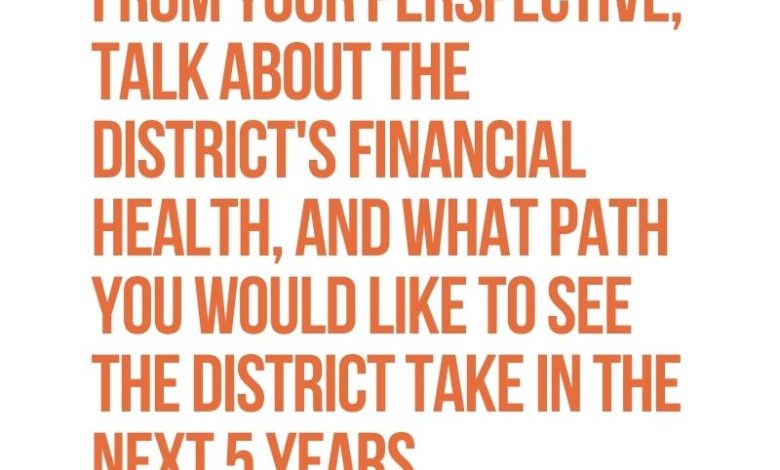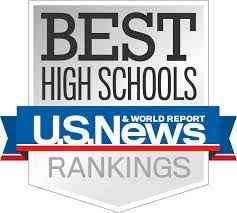From your perspective, talk about the district’s financial health, and what path you would like to see the district take in the next 5 years.

Out-of-Township (Vote for 1)
Patrick MacKay: Based on conversations with constituents, the district’s financial health is an important issue for many people. While I believe the past should be examined because it informs our future, it is the future that we must concern ourselves with. We need a comprehensive 5-year plan that takes into account the different priorities of the district. The identification of priorities should not only incorporate the superintendent’s strategic vision but also the input of the wider community. The board, along with the chief business officer should review said plan at set intervals so as to adjust accordingly based on real and actionable data. These review activities should always be public so as to maintain transparency, disclosure and most importantly engender trust with the community. The community must trust the board to act in the best interests of the district, that it understands and appreciates the importance of its role as custodian of the purse.
For example, with respect to constructing a new school, I would expect the financial committee, together with the district’s chief business officer, to prepare and present different scenario’s with respect to funding and/or financing options and how they impact the district moving forward. As part of this the district would need to scope out the possible costs of building a new junior high school. No doubt, this is also on the minds of the community engagement committee as they discuss the larger facility plan and roadmap for the district.
Justin Lamb: Mahomet-Seymour has a history of outstanding financial management and decision making. Local taxpayers have enjoyed one of the lowest school tax rates in the area and one that has remained flat for the last 30 years. Previous boards have done a great job of doing more with less. The recent commercial construction in town will help to increase our tax revenue without adding new students. The county wide 1% facilities sales tax has been extremely helpful in recent facility upgrades and new construction. It is likely that future new construction projects will require an increase in the tax rate. This is a conversation the district and the community need to have to see if the community is willing to financially support the construction of new buildings.
In-Township (Vote for 2)
Sunny McMurry: Considering that we have one of the lowest tax rates in the county and that we are not adequately funded by state funding, I would say we are doing pretty well! In all seriousness though, our district has been financially stable for several years. There are four levels of financial health as judged by ISBE: Financial Recognition is the highest level, followed by Financial Review, Financial Early Warning and finally the highest risk category of Financial Watch. Mahomet-Seymour School District is at the level of Financial Review. This is a comfortable place to be, but we could be just a little better if we could move our days of cash on hand up from where we currently stand at 85 days. Putting some money back for emergencies would be wise, but if our district continues to grow and we continue to not receive adequate funding from the state, we may not reach that threshold. We need to make sure our schools are sufficiently staffed.
The district is slated to receive federal funding for COVID related expenses, however the state has said there will be no additional tier funding coming to schools this year. The federal funding will obviously help with remote learning needs, such as devices for teachers and students, but it won’t cover all expenses.
Laura Lang: I would like to see the school board work with district financial officer to set attainable fiscal goals to improve our district’s health, and allow us to less reliant on State funding. I think it’s only reasonable that we think through anticipated financial needs over the next five years, and set a workable budget, which determines that route to address the building situation.
Rebecca Richardson: According to the ISBE, our financial status is the lowest status of the five categories, and has been that way for multiple years recently. However, I believe we also need to consider context. In looking at the last five years of financial reports, the district has averaged a $500,000 deficit, so I have some concerns, especially since we are at capacity at all of our current buildings and are borrowed again our county 1% sales tax revenue until 2033. I have more questions than answers, but I believe the next board of directors will have some serious decisions to make in this area that will impact the district and the Village for many years ahead. I understand the weight of this issue going into it, and I am committed to working with other board members, the administration and the community to fully vet the resources we have and to spend them in the most effective way for the most number of students.
Max McComb: When you look at the state’s new funding model: Evidence Based Funding, it’s amazing what we have accomplished. We get excellent student outcomes and we are funded at 65% of what the model says we need in our Education fund. That says a lot about the talent of our staff and the way we have been able to stretch Education fund dollars. Increases to the Education fund are to come from the state from a process called “Tier funding”. When this was put into place, the thought was that the state will add money in tiers each year (most underfunded schools like M-S first) until we are sufficiently funded to meet their model. That worked the first couple of years and we did see some progress, until COVID stressed the already difficult State budget. We have not received additional tier money for two years now, and likely won’t see any tier money any time soon. The model says we are short a few classroom teachers which would give us lower class size and the model says we are short many support positions. We are going to have to carefully prioritize Education fund spending the next 5 years and beyond. Our staff does a great job on reaching out to grants whenever possible to help supplement and that will continue to be important. Our residential property tax base is extremely strong, which of course helps us. We are working with the village in efforts to strengthen our commercial property tax base.
Capital money comes from property taxes and the 1% local sales tax for school infrastructure. These sources are stable and consistent and the record low interest rates we are enjoying have been very helpful. We have done a great job the past several years managing these funds and being able to fund building improvements and of course Middletown Prairie Elementary. There will be some additional capital money available the next few years as debt is paid off, but unfortunately not enough to cover the next round of building needs. Our community is going to have to make some decisions on the direction they would like us to go and how we are going to fund it. Those discussions are starting now and you will hear more about the process later into this Spring and next Fall.
Finally, we are fortunate to employ a very talented School Business Officer. Her input will drive much of the 5 year financial plan along with the input of the entire administrative team and the Board of Education. The financial plan for capital improvements will be highly dependent on the final facilities plan and the level of support for that plan in the community.





